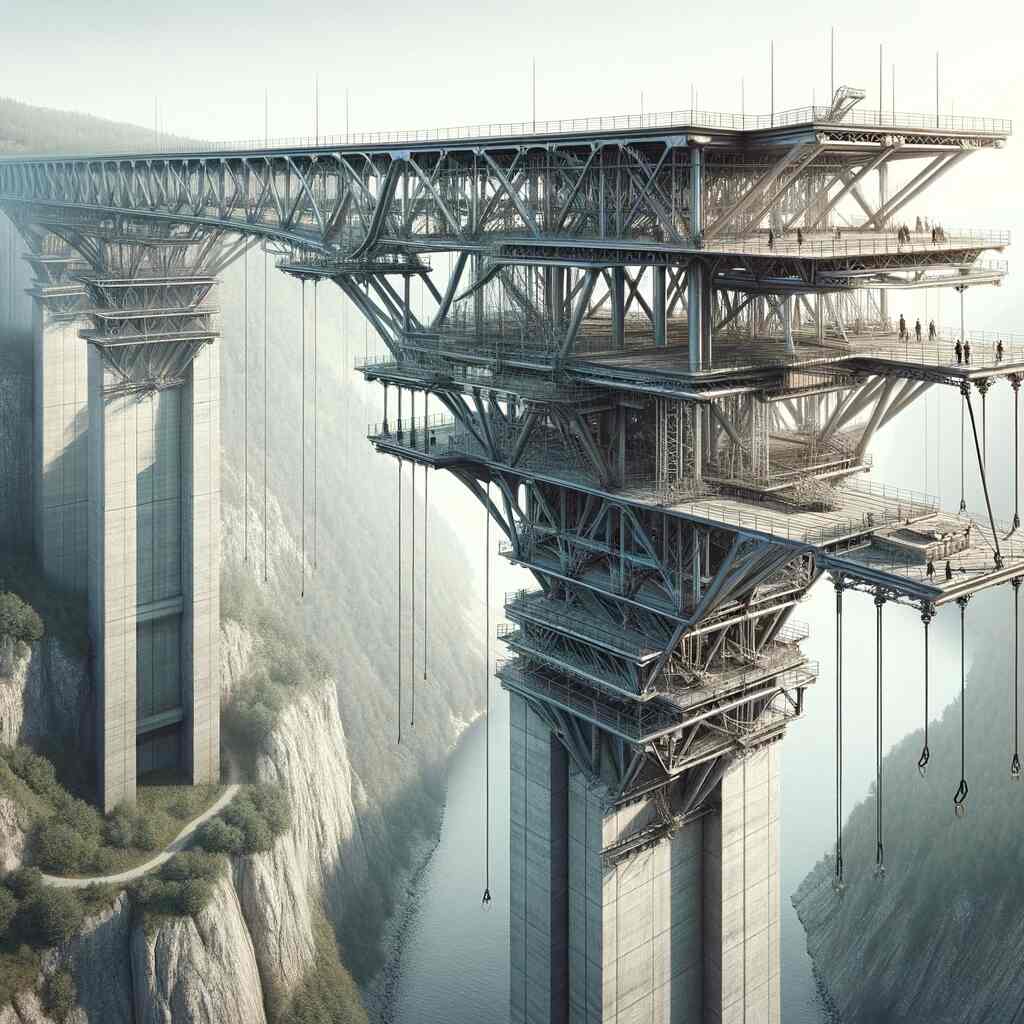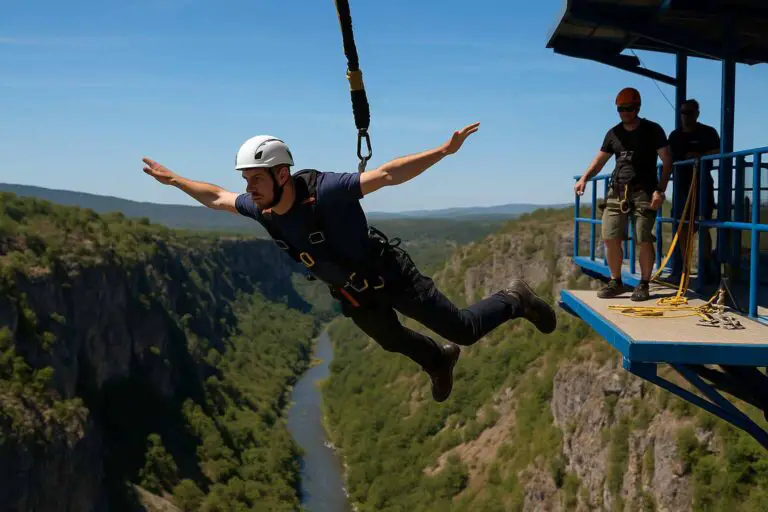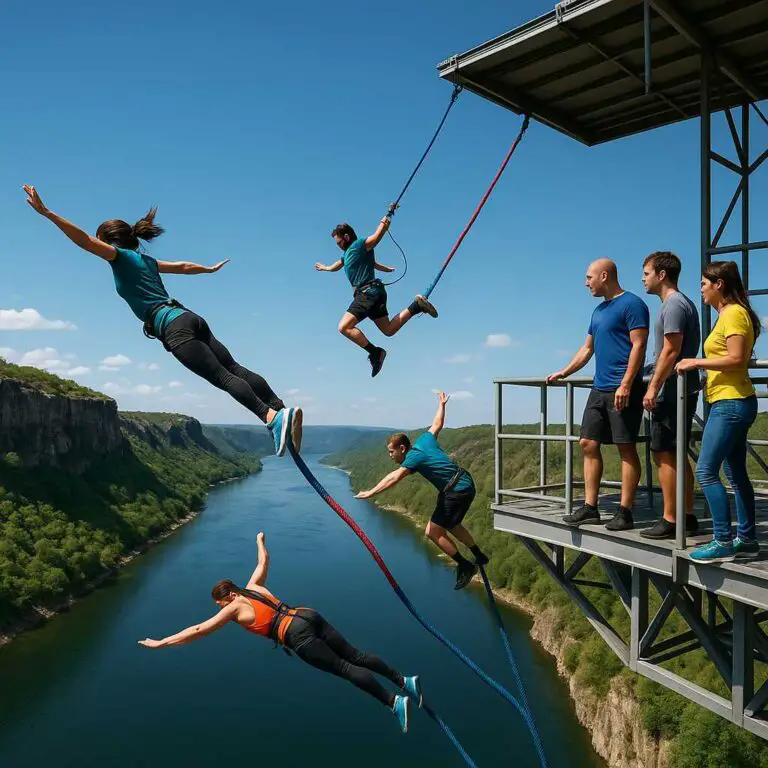Bungee jumping is an exhilarating activity that has captured the hearts of thrill-seekers worldwide. The rush of free-falling from a great height, only to be yanked back by an elastic cord, is an experience like no other. But behind the adrenaline-pumping adventure of bungee jumping lies a complex web of engineering, design, and safety considerations.
Let’s dive deep into bungee jumping platforms and structures to uncover the engineering marvels that make this thrilling activity not only possible but safe.
The Birth of Bungee Jumping
Before we dive into the engineering aspects, let’s take a moment to appreciate the history and origins of bungee jumping. This heart-pounding activity has its roots in the ancient “land diving” rituals of the Pentecost Island in Vanuatu. In these rituals, men would jump from tall wooden platforms with vines tied to their ankles, allowing them to break their fall inches from the ground. These daring leaps were meant to ensure a bountiful yam harvest and were part of a spiritual tradition.
The modern concept of bungee jumping as a recreational activity, however, can be traced back to the 1970s in New Zealand. A group of adventurous individuals, including A.J. Hackett and Henry van Asch, experimented with jumping off bridges with rubber cords tied to their ankles. This marked the beginning of commercial bungee jumping as we know it today.
As the popularity of bungee jumping grew, so did the need for engineering solutions to ensure safety and optimize the thrill factor. Let’s now explore the various engineering elements that go into designing and constructing bungee jumping platforms and structures.
The Physics of Bungee Jumping
At its core, bungee jumping is a physics-driven activity. Understanding the key principles of physics is crucial for engineering safe and enjoyable bungee jumping experiences. Here are the fundamental principles at play:
Elastic Potential Energy
The heart of bungee jumping lies in the elastic potential energy stored in the bungee cord. When a jumper leaps from a platform, they begin to accelerate due to gravity. As they fall, the bungee cord stretches and stores potential energy. This stored energy is what eventually brings the jumper to a stop and propels them back up.
Conservation of Energy
According to the law of conservation of energy, the total mechanical energy of a system remains constant. In the case of bungee jumping, the sum of the kinetic energy (associated with the jumper’s motion) and the potential energy (stored in the stretched bungee cord) remains constant throughout the jump. This principle ensures that the jumper can safely return to the platform without experiencing excessive forces.
Damping
While the conservation of energy is essential for a safe jump, it’s equally important to prevent excessive oscillations or bouncing of the jumper. Damping systems, such as shock absorbers or bungee cord coatings, help dissipate the energy in a controlled manner to reduce oscillations and provide a smoother experience.
Weight and Elasticity of the Cord
The choice of the bungee cord’s material and length is critical. The cord must be elastic enough to provide a gradual deceleration but strong enough to support the jumper’s weight. Materials like latex or rubber are commonly used due to their elasticity and durability.
Designing Bungee Jumping Platforms
Platform Structure
The bungee jumping platform is the starting point for the adventure, and its design is critical for the safety and comfort of jumpers. Several engineering considerations come into play when designing these platforms:
Load-Bearing Capacity
The platform must be structurally sound and capable of supporting the weight of the jumpers, the bungee cord, and the equipment. Engineers must calculate the maximum load the platform will bear and ensure it exceeds the combined weight of all components.
Stability and Anchoring
The platform must be stable and securely anchored to prevent any movement or swaying during jumps. Stability is crucial for jumpers’ confidence and safety. Anchoring methods can vary, including bolting the platform to a solid structure or using counterweights to balance it.
Height and Accessibility
The height of the platform greatly influences the thrill factor of the jump. Engineers must consider local regulations and safety standards when determining the platform’s height. Additionally, ensuring safe and convenient access to the platform is essential for both jumpers and staff.
Safety Features
Safety is paramount in bungee jumping, and several engineering features are incorporated into the platform design to minimize risks:
Harness and Attachment Points
Each jumper wears a harness that attaches to the bungee cord. The attachment points on the harness and the cord itself are carefully designed and tested to ensure they can withstand the forces generated during a jump.
Redundant Systems
Engineers often incorporate redundant safety systems, such as backup harnesses or multiple attachment points, to provide an extra layer of protection in case of equipment failure.
Emergency Procedures
Bungee jumping platforms are equipped with emergency procedures and equipment, including rescue systems and first aid kits, to respond to any unforeseen situations or injuries.
Materials Selection
The materials used in the construction of the platform must be durable and weather-resistant. Common materials include steel, aluminum, and treated wood. Engineers also consider the visual aesthetics of the platform, as it plays a significant role in attracting customers.
The Role of Computer Simulations
Engineering bungee jumping platforms and structures often involves the use of computer simulations. These simulations allow engineers to model the behavior of the system under various conditions and ensure its safety and performance. Simulations can help answer critical questions, such as:
- How will the bungee cord stretch and recoil under different loads?
- What is the maximum force experienced by the jumper and the attachment points?
- How will the platform respond to external forces like wind and temperature changes?
- What is the optimal length and elasticity of the bungee cord for a specific jump height?
By running simulations, engineers can fine-tune the design of the platform and cord to maximize the thrill of the jump while minimizing the risk to the jumper.
Calculating Bungee Cord Length
The length of the bungee cord is a critical factor in determining the safety and experience of the jump. Engineers use mathematical models to calculate the appropriate cord length for a specific jump height. The goal is to ensure that the cord stretches enough to absorb the jumper’s kinetic energy but not so much that it reaches its elastic limit or bottoms out.
Equations of Motion
The equations of motion play a significant role in calculating the cord length. By considering the initial height of the jump, the acceleration due to gravity, and the desired jump height, engineers can determine the length needed for the cord to achieve the desired level of stretch.
Elasticity and Safety Factors
To account for variations in jumper weight and ensure safety, engineers introduce safety factors into their calculations. These factors add a margin of safety to the cord length, preventing it from reaching its breaking point. The choice of the cord material and its elasticity also influences these calculations.
Testing and Quality Control
The engineering process doesn’t end with calculations and simulations. Rigorous testing and quality control measures are essential to ensure the safety and reliability of bungee jumping platforms and equipment.
Load Testing
Load testing involves applying forces to the platform, cord, and harness to simulate the stresses experienced during a jump. This testing ensures that all components can withstand the expected loads without failure.
Material Testing
The materials used in the construction of the platform, cord, and harness undergo extensive testing to verify their strength, durability, and resistance to environmental factors. This includes tensile strength tests, corrosion resistance tests, and more.
Field Testing
Once the platform is constructed, engineers conduct field testing by performing a series of jumps under controlled conditions. This allows them to assess the actual performance of the platform and make any necessary adjustments.
Regular Inspections
Bungee jumping facilities are subject to regular inspections by safety authorities to ensure ongoing compliance with safety standards. Inspections cover everything from equipment maintenance to staff training and emergency procedures.
Environmental Considerations
Bungee jumping platforms and structures are often located in natural settings, such as cliffs, bridges, or canyons. Engineers must take into account the environmental impact of their designs to preserve the surrounding ecosystem and minimize disruption.
Site Selection
Choosing an appropriate site for a bungee jumping platform is crucial. Engineers must consider factors like geological stability, wildlife habitats, and local regulations when selecting a location.
Environmental Mitigation
To minimize the environmental impact, engineers may implement mitigation measures such as limiting the number of jumps per day, using eco-friendly materials, and monitoring wildlife behavior in the area.
Safety Standards and Regulations
The safety of bungee jumping is heavily regulated by national and local authorities. Engineers must adhere to these safety standards when designing and operating bungee jumping facilities. These standards cover various aspects, including platform construction, equipment maintenance, staff training, and emergency procedures.
The Future of Bungee Jumping Engineering
As technology advances and our understanding of materials and safety improves, the field of bungee jumping engineering continues to evolve. Future innovations may include:
Smart Monitoring Systems
The integration of sensors and data analysis could lead to real-time monitoring of the bungee cord’s condition and jumper’s vital signs. This would enhance safety and provide valuable insights for optimizing the jump experience.
Sustainable Designs
Engineers are exploring sustainable design practices that reduce the environmental footprint of bungee jumping facilities. This includes using renewable energy sources, eco-friendly materials, and minimizing waste.
Virtual Reality (VR) Experiences
Advances in VR technology may lead to the development of immersive virtual bungee jumping experiences. These could provide the thrill of the jump without the need for physical platforms, expanding the accessibility of the activity.
Conclusion
Bungee jumping is a thrilling adventure that combines engineering ingenuity with the laws of physics to create a heart-pounding experience. Behind every jump is a carefully designed platform, a meticulously calculated bungee cord length, and a commitment to safety. Engineers and designers work tirelessly to ensure that bungee jumping remains a safe and exhilarating activity for thrill-seekers around the world.
The engineering principles and considerations discussed in this article highlight the dedication to safety and innovation that drive the world of bungee jumping. As technology advances and our understanding of materials and safety improves, we can expect even more exciting developments in the world of bungee jumping engineering, making this adrenaline-pumping activity even more accessible and enjoyable for adventurers everywhere.
So, whether you’re a seasoned bungee jumper or considering taking the plunge for the first time, remember that it’s not just about the thrill—it’s also about the fascinating engineering that makes it all possible.








